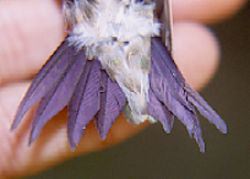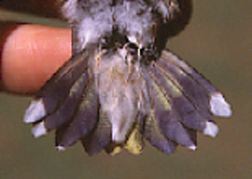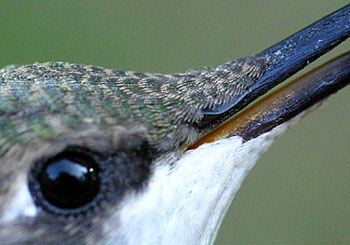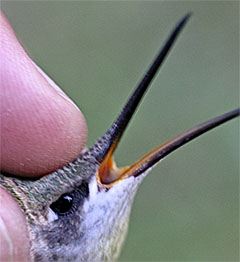|
|
|
|
|
|
|
Adult Ruby-throated Hummingbirds, Archilochus colubris, are sexually dimorphic; i.e., the adult male and adult female are different in external appearance. However, young males "masquerade" as females until their first winter, at which time they attain adult male plumage. This can make ageing and sexing difficult during summer and fall after young of the year have fledged. From May through October, do not assume all white-throated hummers at your feeders are females; some undoubtedly will be young males. Click below for more details about RTHU external characteristics and hints on how to differentiate between age and sex classes.
All hummingbirds are fully grown and capable of flight when they leave the nest; there are no "baby hummingbirds" at feeders. In other words, baby hummingbirds can't fly. Any tiny hummingbird that is hovering at a flower or feeder is undoubtedly a Hummingbird Moth. The bird in the photo above right is a juvenile male RTHU with an incomplete red gorget. (See next section for plumage characteristics.) Up to Top of Page ALL normal Ruby-throated Hummingbirds have metallic green backs, but some appear dingier or brighter. In general, adult males appear darker than females and young males. Remember that hummingbird colors are structural in nature and vary with light intensity and angle. In poor light, a Ruby-throated Hummingbird can look almost black rather than green or red.
ADULT MALES
All text & photos © Operation RubyThroat & Bill Hilton Jr. Only the ADULT male Ruby-throated Hummingbirds has the full red gorget (top photo above) that gives this species its name, although the red may not be apparent if the bird is viewed from the side (bottom photo above). ADULT & JUVENILE FEMALES
All text & photos © Operation RubyThroat & Bill Hilton Jr. Female Ruby-throated Hummingbirds of any age have a white throat that is sometimes marked with faint gray or buffy streaking (two photos above). Older females occasionally have one or two black throat feathers (below); very, very rarely they may have a single red feather on the throat. Note that young males (see next section) resemble females.
JUVENILE MALES (also see above)
All text & photos © Operation RubyThroat & Bill Hilton Jr. A young male Ruby-throated Hummingbird also may have a white throat like a female, but more often it is streaked to a greater or lesser degree with black or green; this gives the appearance of a "five o'clock shadow." The bird just above is the most heavily streaked we have seen; the one above it is more typical.
Near summer's end, young males MAY show one to several red throat feathers but do not get a full red gorget until their first winter. When a young male returns the following spring, some researchers believe his gorget may have an irregular bottom edge (below), and one or more of the throat feathers may be brownish instead of red; this may be a useful ageing characteristic but needs further study.
To our knowledge, all young male Ruby-throated Hummingbirds develop a full red gorget on their tropical wintering grounds, so when they return to the U.S. and Canada in spring they look like typical adult males. Very rarely, individuals that overwinter in the U.S. rather than in Mexico or Central America may show "arrested development" in which they retain dark throat streaking until late spring and then within days acquire the full red gorget. Up to Top of Page  
All text & photos © Operation RubyThroat & Bill Hilton Jr. Adult male Ruby-throated Hummingbirds (above left) have pointed rectrices (tail feathers) that are all dark with no white tips; the tail is forked. However, young males (above right)--like females of any age--have white tips on the outer three rectrices on each side; each feather is rounded and the tail is fan-shaped. This similarity between females and young males complicates trying to determine the sex of free-flying hummingbirds at feeders in early summer after young begin to fledge. In spring, however, any bird with white tail tips is an adult female.
All text & photos © Operation RubyThroat & Bill Hilton Jr. The bill of the Ruby-throated Hummingbird is dull-to shiny-black; it sometimes appears whitish or yellowish because of pollen deposits. The bill of young birds is lightly etched with tiny lines called "corrugations" (above) that either fill in and/or wear down starting at the tip. This creates a smooth appearance after about 6-8 months; even adult birds, however, can show corrugations near the base of the bill. Corrugations (which most people require a magnifier to see) are usually only visible on birds-in-the-hand. In the second photo above, the tip of the bill already shows some smoothing, so this bird would be scored as having about 80% corrugations--a young bird late in its first summer. As in many bird species, the gape (corner of the mouth) is yellow in young birds (see both photos below), and ivory, white, or pinkish-white in adults.  . .
All text & photos © Operation RubyThroat & Bill Hilton Jr. Up to Top of Page
Up to Top of Page WING The wing of a Ruby-throated Hummingbird appears curved and pointed when held at rest against the bird's side. The tip of the wing extends well past the junction of the body and tail and usually past the tip of the tail itself. In flight, the wing has the shape of a tall right triangle. The relative length of the wing against the body is one field mark that sometimes can be used to identify North American hummingbirds. In the hand, a close look at the tip of the #6 primary feather can be used to confiorm the sex of even a young RTHU. Males always have tapered and sharply pointed #6 primaries (below left and bottom), while in females this feather is more or less rounded (below right). FOOT
NOTE: Ruby-throated Hummingbirds with aberrational plumage sometimes occur. These include albinos and leucistic birds with varying degrees of pale or white feathers. Please report sightingss of these birds to Operation RubyThroat at Hilton Pond Center. For details about these unusual plumages, click on the photo below. |
Up to Top of Page
|
Make direct donations on-line through
Network for Good: |
 |
|
LIKE TO SHOP ON-LINE?
Donate a portion of your purchase price from 500+ top on-line stores via iGive: |
|
|
Use your PayPal account
to make direct donations: |
|
|
|
Share Your Hummingbird Experiences Through "Hummingbird Hobnob" |
 |
Operation |
|
|